
Rainbow Islands: The Story of Bubble Bobble 2 (レインボーアイランド) is a 1987 arcade video game developed and published by Taito, with the arcade version licensed to Romstar for North American manufacturing and distribution. The game is the sequel to Bubble Bobble from the previous year, and it is the second of four arcade games in the series. The game was ported to home computers and home video game consoles.
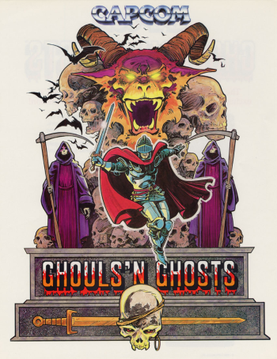
Ghouls 'n Ghosts, known as Dai Makaimura in Japan, is a side-scrolling platform game developed by Capcom, released as an arcade video game in 1988 and ported to home platforms. It is the sequel to Ghosts 'n Goblins and the second game in the Ghosts 'n Goblins series.

Operation Wolf is a light gun shooter arcade game developed by Taito and released in 1987. It was ported to many home systems.

Golden Axe is a side-scrolling hack-and-slash video game released by Sega for arcades in 1989, running on the Sega System 16B arcade hardware. Makoto Uchida was the lead designer of the game, and was also responsible for the creation of the previous year's Altered Beast. The game casts players as one of three warriors who must free the fantastical land of Yuria from the tyrannical rule of Death Adder, who wields the titular Golden Axe.
1991 saw many sequels and prequels in video games, such as Street Fighter II, Final Fantasy IV, Super Castlevania IV, Mega Man 4, Super Ghouls 'n Ghosts, and The Legend of Zelda: A Link to the Past, along with new titles such as Sonic the Hedgehog, Battletoads, Lemmings, Sunset Riders, Duke Nukem, Fatal Fury: King of Fighters, and Streets of Rage. The year's highest-grossing video game worldwide was Capcom's arcade fighting game Street Fighter II. The year's best-selling system was the Game Boy for the second year in a row, while the year's best-selling home video game was Sega's Sonic the Hedgehog, which was also the year's top video game rental in the United States.
1990 saw many sequels and prequels in video games, such as Metal Gear 2: Solid Snake, Dr. Mario, Dragon Quest IV, Final Fantasy III, Phantasy Star II, and Super Mario World, along with new titles such as Fire Emblem: Shadow Dragon and the Blade of Light and Magic Sword. The year's highest-grossing arcade video games were Final Fight in Japan and Teenage Mutant Ninja Turtles in the United States. The year's best‑selling system was the Game Boy, while the year's best-selling home video game was Super Mario Bros. 3 for the Nintendo Entertainment System.
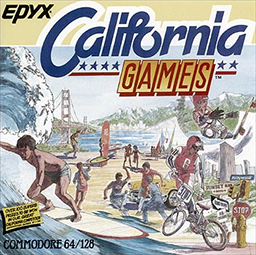
California Games is a 1987 sports video game originally released by Epyx for the Apple II and Commodore 64, and ported to other home computers and video game consoles. Branching from their Summer Games and Winter Games series, this game consists of a collection of outdoor sports purportedly popular in California. The game was successful and spawned a sequel, California Games II.
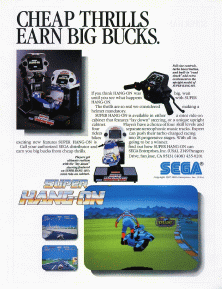
Super Hang-On is a motorcycle racing arcade video game released by Sega as the sequel to Hang-On. It uses a simulated motorcycle arcade cabinet, like the original game. An updated version was released in arcades 1991 as Limited Edition Hang-On.

Xenon 2: Megablast is a 1989 shoot 'em up video game developed by The Bitmap Brothers and published by Image Works for the Amiga and Atari ST. It was later converted to the Master System, PC-98, X68000, Mega Drive, Commodore CDTV, Game Boy, Acorn Archimedes and Atari Jaguar platforms. The game is a sequel to Xenon and takes place a millennium after the previous title. The goal of the game is to destroy a series of bombs planted throughout history by the Xenites, the vengeful antagonists of the first game.

Double Dragon is a 1987 beat 'em up video game developed by Technōs Japan and distributed by Taito for arcades across Asia, North America and Europe. It is the first title in the Double Dragon franchise. The game's development was led by Yoshihisa Kishimoto, and it is a spiritual and technological successor to Technos' earlier beat 'em up, Nekketsu Kōha Kunio-kun (1986), released outside of Japan by Taito as Renegade; Kishimoto originally envisioned it as a direct sequel and part of the Kunio-kun series, before making it a new game with a different cast and setting.

Forgotten Worlds, titled Lost Worlds in Japan, is a side-scrolling shooter video game by Capcom, originally released as a coin-operated arcade game in 1988. It is notable for being the first title released by Capcom for their CP System arcade game hardware.
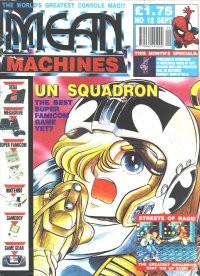
Mean Machines was a multi-format video game magazine published between 1990 and 1992 in the United Kingdom.
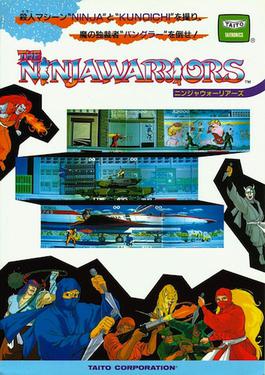
The Ninja Warriors (ニンジャウォーリアーズ) is a side-scrolling beat 'em up video game developed and released by Taito in 1987. The original arcade game situated one display in between projected images of two other displays, creating the appearance of a triple-wide screen. Ports were released for home systems including the Amiga, Atari ST, ZX Spectrum, Commodore 64, Amstrad CPC, PC Engine, and Sega Mega-CD.

Super Monaco GP is a Formula One racing simulation video game released by Sega, originally as a Sega X Board arcade game in 1989, followed by ports for multiple video game consoles and home computers in the early 1990s. It is the sequel to the 1979 arcade game Monaco GP. The arcade game consists of one race, the Monaco Grand Prix, but later ports added more courses and game modes based on the 1989 Formula One World Championship.

Indiana Jones and the Last Crusade: The Action Game was published in 1989 by Lucasfilm Games, based on the film of the same name. The game was released for the ZX Spectrum, Amstrad CPC, Commodore 64, Atari ST, Amiga, IBM PC, MSX, Master System, NES, Game Boy, Sega Genesis and Game Gear.

Hostages is a 1988 tactical shooter video game developed and published by Infogrames for the Acorn Electron, Archimedes, Atari ST, Amiga, Apple IIGS, Amstrad CPC, BBC Micro, Commodore 64, MS-DOS, MSX, Nintendo Entertainment System, and ZX Spectrum. The game depicts a terrorist attack and hostage crisis at an embassy in Paris, with the player controlling a six-man GIGN counterterrorist team as they are deployed to defeat the terrorists and free their hostages.
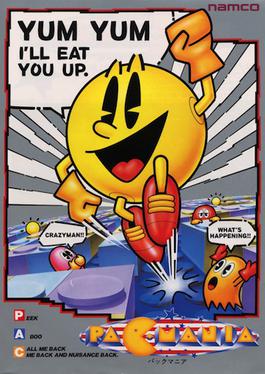
Pac-Mania is a cavalier perspective maze game that was developed and released by Namco for arcades in 1987. In the game, the player controls Pac-Man as he must eat all of the dots while avoiding the colored ghosts that chase him in the maze. Eating large flashing "Power Pellets" will allow Pac-Man to eat the ghosts for bonus points, which lasts for a short period of time. A new feature to this game allows Pac-Man to jump over the ghosts to evade capture. It is the ninth title in the Pac-Man video game series and was the last one developed for arcades up until the release of Pac-Man Arrangement in 1996. Development was directed by Pac-Man creator Toru Iwatani. It was licensed to Atari Games for release in North America.
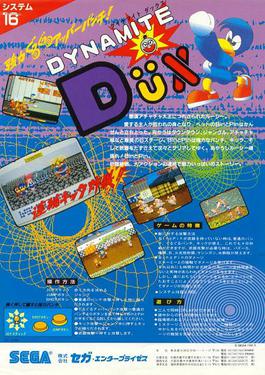
Dynamite Düx is a beat 'em up developed by Sega AM2 and released by Sega as an arcade video game in 1988. Produced by Yu Suzuki and with music composed by Hiroshi Kawaguchi, the game uses the Sega System 16 arcade board, the same board used for Golden Axe and Altered Beast. It was ported to the Master System, Amiga, Amstrad CPC, Atari ST, Commodore 64, and ZX Spectrum platforms in the following year. A Mega Drive version was planned but never released.

Micro Machines is a racing game developed by Codemasters and originally published by Camerica for the Nintendo Entertainment System in 1991. Themed around Galoob's Micro Machines toys, players race in miniaturised toy vehicles around various environments. The game is the first installment in the Micro Machines video game series.
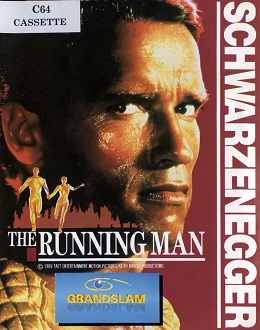
The Running Man is a 1989 beat 'em up video game based on the 1987 film of the same name. It was developed by Emerald Software and published by Grandslam Entertainments for Amiga, Amstrad CPC, Atari ST, Commodore 64, and ZX Spectrum.


















